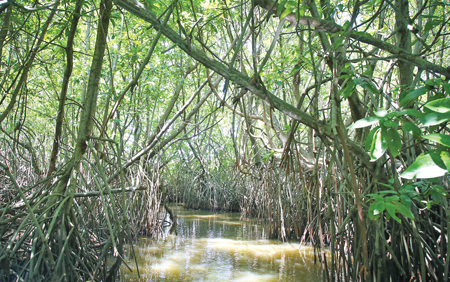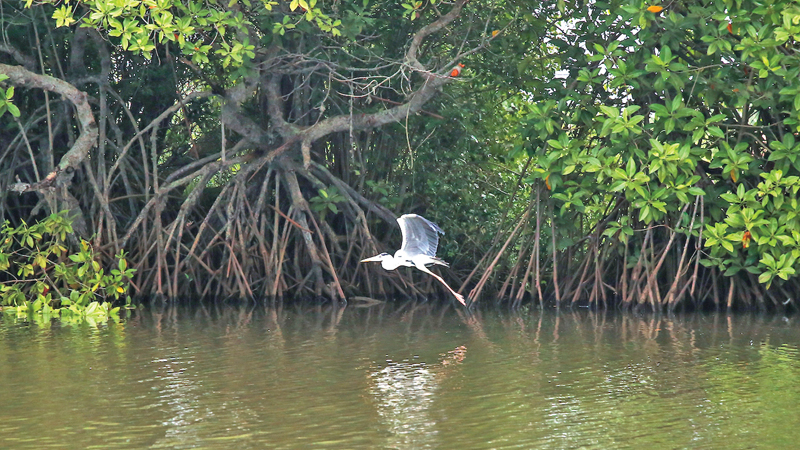 Like all other plants, mangroves also need fresh water, sunlight, oxygen and nutrients. To meet these needs, they breathe through special roots that grow upwards, filter out salt and strengthen themselves against tides and storms. Nature always finds a way. Growing in acidic soil with little air, mangroves teach us an important life lesson, the art of adaptation in surviving difficult conditions. As the saying goes, “When the going gets tough, the tough get going”.
Like all other plants, mangroves also need fresh water, sunlight, oxygen and nutrients. To meet these needs, they breathe through special roots that grow upwards, filter out salt and strengthen themselves against tides and storms. Nature always finds a way. Growing in acidic soil with little air, mangroves teach us an important life lesson, the art of adaptation in surviving difficult conditions. As the saying goes, “When the going gets tough, the tough get going”.
Sri Lanka, being an island nation, has about one-third of its population living along the coastal belt. For those in areas like the Puttalam Lagoon or the estuaries along the southern, south-western, or north-eastern coasts, mangroves have always been a familiar part of the surroundings.
While finding special ways to survive in tough conditions, mangroves also create rich and vibrant ecosystems full of life. They have provided us firewood, fish, crabs, and even traditional medicines for generations. Yet, not many have paused to think about the bigger role of these tangled trees in our lives. Mangroves quietly protect our shores from erosion, help clean polluted waters, store carbon to fight climate change, and provide safe homes for fish, birds and other wildlife that support the rich and unique biodiversity in these areas.
Diversity of ecosystem

Muthurajawela mangroves
Mangroves are woody, seed bearing, highly specialised plants ranging in size from shrubs to tall trees. Sri Lanka is home to 21 species of true mangroves and about 18 species of mangrove associates. True mangroves are species specifically adapted to the intertidal zone, characterised by saltwater inundation and fluctuating water levels, while mangrove associates are plants that can also be found in terrestrial or other aquatic habitats but occasionally grow in mangrove environments. Mangrove animals depend on these plants for food, shelter and breeding grounds.
Common mangrove plants in the country include Kadol, Malkadol, Punkanda/Rathugas, Kirilla, Mandagas, Heen kadol/Averi kadol, Mulli/Katu ikkili, Thela, Mutti kadol, Gin pol and Bariya, a report compiled by the Coast Conservation Department said.
Grapsid crab (Mada kakuluwa), Fiddler crab (Thani andu kakuluwa), Lagoon crab (Kalapu kakuluwa), Sea crab (Sinakkali), Mud lobster (Mada pokirissa), White prawn (Kalissa), Mangrove clam (Mutti), Telescope shell, Mudflat shell (Uri), Mangrove periwinkle (Kadol bella), Mangrove oyster (Kavati), Mud skipper (Diya huna), Little green heron (Kadol koka), Egret (Ali kokka), Terns and gulls (Mudu lihiniya) and Sand pipers (Silibilan) are some of the common animals found in mangrove ecosystems, the report added.
According to a survey conducted by the Forest Conservation Department in 2021, mangrove forest cover in the country is estimated at 19,758 hectares, accounting for one percent of Sri Lanka’s total forest cover of 29.2 percent, said Environment Ministry Director (Climate Change) Leel Randeni.
“Mangroves are recognised as one of the most efficient carbon sinks on Earth. They are capable of storing up to four times more carbon per hectare than tropical rainforests like Sinharaja or Kanneliya,” he said.
As the United Nations Educational, Scientific and Cultural Organization (UNECSO) puts it, one hectare of mangrove can store 3,754 tons of carbon, which is equivalent to taking more than 2,650 cars off the road for one year. This makes them valuable assets in carbon trading, an initiative that environmental authorities are actively exploring.
Parallel to this year’s World Mangrove Day, officially known as the ‘International Day for the Conservation of the Mangrove Ecosystem’, the Environment Ministry yesterday (July 26) declared eight mangrove forests in the Puttalam District as reserves. The newly designated forest reserves include Marambettiya and Vavulkele in Madampe, Merawala, Merawala A, B, and C in Chilaw, and Kusala and Karukapane B in Arachchikattuwa, collectively covering approximately 66 hectares.
Environment Deputy Minister Anton Jayakody said that 19 out of the 21 true mangrove species recorded in Sri Lanka can be found in the Puttalam District, which accounts for about 25 percent of the country’s coastline. Among them are several endangered plants such as Mal Kadol (Bruguiera gymnorhiza), Yak Kirala (Sonneratia alba), Mutti Kadol (Xylocarpus granatum) and Kalu Kadol (Scyphiphora hydrophylacea).

Mangrove trees are remarkably adapted to survive in intertidal zones
Despite their importance, mangrove vegetation has been shrinking along with the fish populations they support, said the Deputy Minister, emphasising the Government’s commitment to restoring degraded mangrove ecosystems and promoting sustainable livelihoods for the communities that depend on them.
Forest Conservator General Chandima Palamakumbura said that while the tourism industry and shrimp and crab farms thrive in the area, various constructions associated with these sectors, along with salterns, have largely contributed to the destruction of these sensitive ecosystems.
What we are losing is our island’s first line of defence against rising seas, storms, and the mounting pressures of climate change. The 2004 Indian Ocean tsunami was a key incident that revealed the importance of mangroves as a coastal bio-shield. The cost of destroying mangroves is not only environmental, but also economic, social, and deeply personal for coastal communities that rely on healthy coastal ecosystems for their survival.
Conservation efforts
With the declaration of these areas as forest reserves, the environmental authorities are now empowered to take legal action against those who destroy mangroves, and manage and conserve them more effectively. “The penalty includes a jail sentence up to five years or a fine ranging from Rs. 10,000 to Rs. 100,000. In addition, the damage to the ecosystem can be recovered from the offender after an assessment,” said the Forest Conservator General.
He said that around 300 hectares of mangrove vegetation in the Mannar, Puttalam, Negombo, Trincomalee and Ampara Districts have been restored since 2020, with support from Non-Governmental Organisations. “We have set annual targets, and this year we plan to restore 20 more hectares,” he added, also requesting the public to actively support mangrove conservation.
Without mangroves, our coast would be far more vulnerable, and so would we. If you live near the coastline, remember that, mangrove areas should not be cleared for housing, aquaculture or other development. Sri Lanka’s limited mangrove resources are under threat. Let’s refrain from further destruction.









